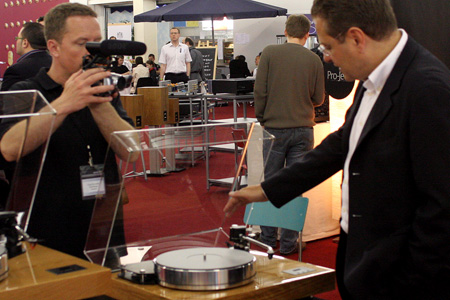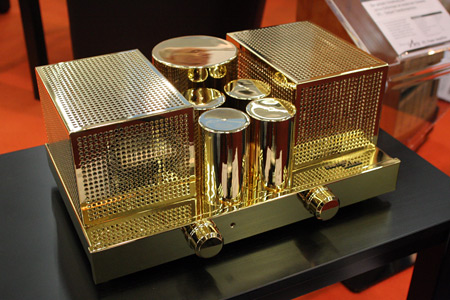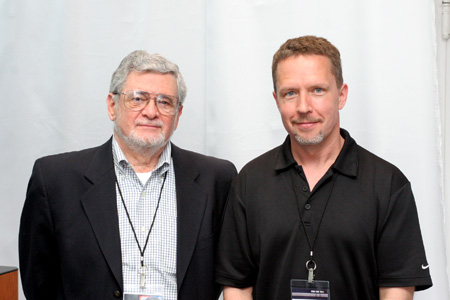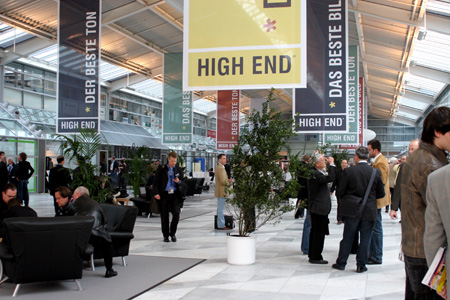|


|
Doug Schneider Sunday, April 27
Yesterday I talked about my conversation with Dr. Burkhardt
Schwabe, whose company is resurrecting one of Julias Futterman's OTL designs, making it
with today's manufacturing know-how and parts. Well, quite by accident, I talked to
another company president who says he sometimes does the same thing. His name is Heinz
Lichtenegger, president of Pro-Ject, which is based in Austria. Pro-Ject is most famous
for its turntables, but the company also makes other products.

I was busy videotaping Heinz talk about one of his new
turntables for our SoundStageV.com
site. As he was describing it, he was talking about the wealth of features it has, but, to
my surprise, as he described those features, he also told us where most of those ideas
originated -- and it wasn't necessarily at Pro-Ject. In fact, many of the true innovations
happened decades ago.
I found this interesting, but it was also a bit baffling,
because so often I've listened to company owners and designers talk about every feature in
their products as if they were all their very own -- basically, inventing the wheel over
and over again. Perhaps this occurs because they think that if they don't do that, then
people won't think that their products are special enough. But often I know full well that
many of these "original" ideas aren't that original at all.
I found Lichtenegger's candor refreshing, and I found his
products to be very intriguing, particularly the nifty, new, modular, micro-sized Pro-Ject
components that we featured in our ShowStoppers -
Series 2 section.
Saturday, April 26
Today I had another interesting conversation, this time
with Dr. Burkhardt Schwabe who owns a company in Germany called Audiophile Gateway,
producing a new line of products under the Eternal Arts brand name.
His goal with the company is interesting: He's taking
older, established technologies and building products with them that use today's
manufacturing know-how and parts quality. He's not re-inventing the wheel -- he's just
trying to make it better. The product on display here is an OTL (output transformerless)
amp based on the designs of Julius Futterman, a man who is credited with designing the
first commercially viable OTL amplifier. Futterman died in 1979. If you want to read
something on him and the OTL topology in general, you can do so on Wikipedia.org.

Schwabe isn't the first to market Futterman designs. Harvey
Rosenberg created New York Audio Labs in order to do the same thing. However, that company
has long since folded, and Rosenberg has passed away.
I'll be interested in how Schwabe makes out with his
project. The amps he showed here, particularly the one decked out all in gold, are
products you'll read about in tomorrow's coverage. If enough people take notice of them
and wish to have a thoroughly modern OTL design, then Audiophile Gateway has a fighting
chance.
Friday, April 25

Anyone who knows me knows that if
there's one thing I like to talk about it's loudspeakers. In Germany, I ran into Dr.
Joseph D'Appolito, one of the most respected and best-known speaker designers in the
world. He's also one of the most knowledgeable, writing books and papers on the subject,
and he even has his name attached to one of the most common design principles used today
in loudspeaker design: the D'Appolito configuration.
Despite his time in the industry (since the '60s), he seems
as enthusiastic as ever, and even with all his successes, he's down-to-earth and
approachable -- a clearly spoken, no-BS type of guy. So, in Munich, I had quite a long
chat with him. In fact, if he charged me a consulting fee (he has consulted to a number of
companies over the years), I'd probably have a pretty big bill now.
But Dr. D'Appolito wasn't in Munich to talk to me. He's the
chief designer for Snell these days, and he's the mastermind behind Snell's new Illusion
loudspeaker, which retails for $50,000 USD/pair. In fact, Jeff Fritz and I thought so much
of the sound of the system in which the Illusion was playing that we named it a Standout.
Thursday, April 24

I remember not that many years ago,
when High End was still being held in Frankfurt, at the press conference that opened this
event, the High End Society made the surprising announcement that the show was moving to
Munich the next year. For the rest of the show, people were asking things like: "Will
it be the same?" "What will it be like?" "Will High End survive?"
For the most part, there was fear that the move could spell the end of High End in
Germany.
However, one thing was for certain: When High End 2004
started, most of those fears were laid to rest. And when it ended, there were no longer
any fear at all -- the move to Munich was a resounding success and most people saw only
growth and prosperity in future years.
Fast-forward to 2008 and I can say with confidence that
after only one day of High End, this is the best show yet. High End has added exhibit-hall
space, allowing for more exhibitors than ever. Furthermore, we're seeing more product
introductions than ever before. For specialty A/V, It's the best European event that we
know of, and other than than CEDIA and CES, no North American-based event comes close to
the scale and scope of Munich's High End.
In hindsight, some may think that the fear that many had
after the Frankfurt announcement was silly. It wasn't -- moves like that have the
potential to destroy even a well-established show. However, in High End's case, it made a
great show even better. Obviously, then, for as long as we can foresee, we'll be covering
High End. But I don't want to get too much ahead of myself -- this is only day one, and
the show has only just begun. There are still three more days to go and plenty of coverage
to get. Of course, you're going to see it all here in the days to come. Keep checking
back.
|
|
|

